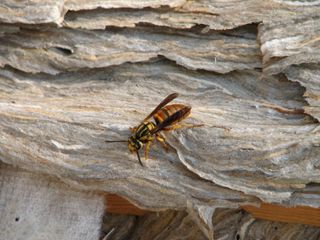Yellow Jacket 'Super Nests' the Size of Cars Are Popping Up in Alabama
Yellow jackets in Alabama may be in the midst of a colossal craze; they're making humongous "super nests" that can house 15,000 worker wasps, according to an entomologist there.
That's three to four times the size of typical wasp nests, which are the size of a volleyball and house about 4,000 to 5,000 workers, said Charles Ray, an entomologist with the Alabama Cooperative Extension System (ACES).
Why is this happening? It's likely because Alabama had a mild winter and there's plenty of food for these hungry insects, which usually don't survive the cold winter months, Ray said. [Photos: Peer at Glittering Insect Eyes and Glowing Spider Babies in Prizewinning Photos]
The last time super nests plagued Alabama, following the mild 2005-2006 winter, Ray saw 90 of them. This past winter was also mild in Alabama (although Ray still has to analyze temperature records to be sure), and ACES has already found two such nests in May and is investigating 19 more.
"This puts us several weeks earlier than in 2006, when we identified the first giant nest on June 13," Ray said in a statement. "If we are seeing them a month sooner than we did in 2006, I am very concerned that there will be a large number of them in the state. The nests I have seen this year already have more than 10,000 workers and are expanding rapidly."

Yellow jackets, a type of wasp, are smart creatures. But they usually aren't friendly when humans are around. They tend to build their papery nests in cavities — such as abandoned burrows in the ground or within the walls of a building. If a person gets too close, within about 14 inches (36 centimeters) of a nest's opening, the resident wasps will defend themselves, mercilessly stinging the person.
And, unlike honeybees, yellow jackets can sting multiple times without dying. However, they usually have less venom to inject following the first sting, said Ray, who is also a research fellow in the Department of Entomology and Plant Pathology at Auburn University.
Sign up for the Live Science daily newsletter now
Get the world’s most fascinating discoveries delivered straight to your inbox.
In a typical summer, each yellow jacket colony headed by one queen will make a nest. The nest usually reaches its peak size in August. But this triumph is short-lived; when colder weather hits, the workers tend to freeze to death or die of starvation. Usually only the queen, who has antifreeze-like compounds in her blood, survives.
But when a region has a mild winter and an abundant food supply — anything that offers sugar and carbohydrates, such as tree sap, aphids and other insects — the workers tend to survive, and continue operating in the nest. Over time, that nest gets bigger and bigger. These super nests, also called perennial nests, that last more than one year can reach enormous sizes and often involve multiple queens. However, it's unclear if the queens are related to one another or whether they're strangers that decided to become neighbors, Ray told Live Science.

The largest nest he's laid eyes on took up the interior of a 1957 Chevy, Ray said. And these super nests aren't popping up only in Alabama. There are also reports of them in California. Ray and his Golden State colleagues plan to put together a proposal for a grant so they can study these nests more, he said. [No Creepy Crawlies Here: Gallery of the Cutest Bugs]
There is one silver lining: Yellow jackets that live in these gigantic nests tend to be less aggressive than is typical, Ray told Live Science.
"If you leave this nest alone and do not disturb it, and if it's in a place you can do that, they will not bother you. The undisturbed large nest is very docile compared to a little nest in the ground," Ray said. "They really don't seem to care if you're there."
He added that if a super nest can't be avoided, don't try to dispose of it yourself, as that can end badly. After all, one super nest in South Carolina had 250,000 workers, and nobody needs that many angry wasps picking a fight. Instead, he said, call an exterminator.
- Gallery: Dazzling Photos of Dew-Covered Insects
- Image Gallery: Shimmering Metallic Beetles
- Googly Eyes: Photos of Striking Wasp Faces
Originally published on Live Science.

Laura is the archaeology and Life's Little Mysteries editor at Live Science. She also reports on general science, including paleontology. Her work has appeared in The New York Times, Scholastic, Popular Science and Spectrum, a site on autism research. She has won multiple awards from the Society of Professional Journalists and the Washington Newspaper Publishers Association for her reporting at a weekly newspaper near Seattle. Laura holds a bachelor's degree in English literature and psychology from Washington University in St. Louis and a master's degree in science writing from NYU.
Most Popular

